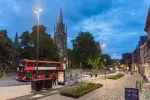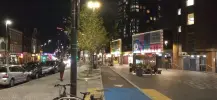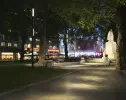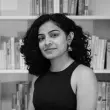Your Interview Betty Atine

Betty Atine
Designer, Engineer
United Kingdom
Introduce yourself (name, company, position, country) and tell us how you got into lighting design (including education/qualifications).
My name is Betty Atine and I am an independent lighting consultant specialising in urban and architectural lighting design and highway lighting. Our company is called Arch’ Eng L Design Limited, based in Winchester, United Kingdom. I am a member of the Society of Light and Lighting (SLL) Education Committee.
Light has always been something in me, which gives me a kind of awe and wonder. My first awareness of light was my first encounter with my blind great grand-father. He appeared to me as a strong old man with a deep voice, but I also saw in him a powerless man questioning and touching things in order to identify them. Through this experience, I discovered the gift of sight and the beauty of light.
When I went to study at Lyon in France, my passion for artificial lighting grew while attending the lighting festival in Lyon. At this moment, I knew what I would like to do in life: being a lighting designer. In France, we did not have a master degree in light and lighting. Therefore I began my formation in Electrotechnical engineering and worked as a volunteer in a theatre to gain experience in stage lighting. In my late twenties, I came in contact with an association of architects and urban planners for which I offered ‘my expertise in lighting’ as a volunteer to produce a lighting master plan for the security and regeneration of the city of Santa Tecla (El Salvador) at night.
Living and working in El Salvador made me realise the importance that lighting plays in the dynamic of a city and the experience of the individuals in relation to the public space in the night-time environment. As a young entrepreneur, I received sponsorships and awards for this project.
A year later, I moved to the UK where I worked as a trainee lighting engineer for Design for Lighting & Hampshire County Council. Here I was able to extend my interest in the lighting field. I have always been fascinated by the science of light, and London was the place to be regarding innovative lighting research technology and creativity. I received a sponsorship from the Institution of Lighting Professionals and Lightmongers to study the Lighting Education Trust (LET) diploma. After the LET diploma, I studied as a part-time student the master of Light and Lighting at Bartlett - University College London.
My work experience and lighting formations were also enriched by the SLL and ILP lectures. These lectures allowed me to get some practical knowledge and have great mentors in the lighting industry to develop my career. The reason I like my profession is that it is a pleasure to see the inhabitants and tourists joyfully using a social space that I have designed along with architects, engineers and the members of the local authorities.
Tell us about your work – is there a specific type of project you like to work on or an area you specialise in and why?
I am fascinated by daylight and artificial lighting because those uplift and transform a space considerably and consequently this has a positive impact on the well-being of the users. However, my career path has always been in urban and architectural lighting, road lighting and lighting strategy. I am also involved in product design and lighting master plan.
I like exterior lighting because it is the combination of engineering solutions and creative design. I like working with a multidisciplinary team and being the bridge between the engineers and the architect. The engineers and contractors are concerned with buildability, sustainability, maintenance and safety, while the architects or artists mainly focus on a certain aesthetic. In between, we have the project manager who monitors the cost. Our goal, as a design team, is to deliver a better living and social space environment to the public, and this in itself makes the job exciting.
The innovation of lighting technology and new research in the lighting field require continuous learning development for my career. The applications of lighting design are not repetitive, and I do like new challenges in design.
What project are you most proud of and why?
I do like all the projects I have been involved in because of the vision and the team spirit to concretise a project. It is great fun!
I especially enjoyed working on the Leicester Square lighting design and its delivery for the 2012 Olympics together with Burns+Nice, iGuzzini and the Westminster City Council. I worked on the functional and landscape lighting and product design plus the electrical design. LED bespoke lighting was new, and I had demonstrated that the bespoke LED lighting produced the suitable lighting levels in the square and ease of maintenance without compromising the aesthetic aspect of the design. My understanding of lighting science was a great advantage to convince the local authority to approve the bespoke lighting columns.
A similar project, but more recent, was the lighting refurbishment (road and architectural) of Stratford Gyratory for Newham Borough Council. The application of new lighting technology and research study has transformed the urban space, and saved energy and reduced maintenance.
I was very pleased when a client told me recently that my architectural lighting design is still working 15 years after installation.
Creativity and longevity are always part of the core of my design.
What is the biggest challenge that you have overcome in your career?
Being self-employed with a work-life balance.
I like my work and the clients (the local governments and the users) for whom I work.
I hope my business will continue to get opportunities to work on outstanding projects.
How does light inspire you?
Photography is a way to capture lighting.
Beauty reveals itself through light.
Let there be light, and let us be transformed by it in order to share it with others.
We are all spectators of the beauty of creation. I simply try to imitate creation.
What is your message for other Women In Lighting?
A lighting design engineer is not just putting up a few street lighting columns in the public space.
It is a bit more complex.
From my perspective, being a lighting design engineer means first being in service of the community by knowing the historical, social and economic contexts of the environment to be lit, listening to the appointed architect as well as the engineers and contractors to have an overview of the project, being able to feel the visual rhythm of the space, working with different disciplines that broaden your knowledge in civil engineering and using lighting technology that enhance the urban space while saving energy in a smart way though not to the detriment of safety and aesthetic.
Learning from others in order to broaden your knowledge - Professional network is a key to success. The lighting associations are a friendly professional environment to grow. I would not be what I am today in the lighting profession without mentoring of other lighting professionals.
The subject of light and lighting is broad and fascinating.
Keep your interest in lighting on and you will not be disappointed.
“The subject of light and lighting is broad and fascinating.
Keep your interest in lighting on and you will not be disappointed.”
Selected portfolio:







_-_28de80_-_8361d044d2edec1980f143c24d13d209c3de6258.webp)

